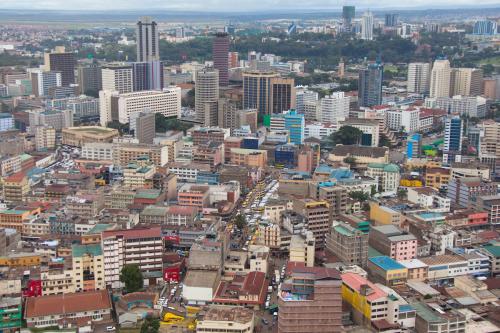Editor’s Note: The Commission on Growth and Development, chaired by Nobel Laureate Michael Spence and led by leading development practitioners , launched Strategies For Sustained Growth And Inclusive Development on May 21. Written over two years, the report examines areas of high economic growth and how to sustain the growth over time. Understanding the political and global factors involved and the complexity of the growth process, the report outlines how sustainable growth can be achieved so that developing countries can implement and evaluate successful development interventions.
The Growth Commission concluded that urbanization is both a great challenge and a great opportunity for developing countries in their quest for growth. To quote the most relevant conclusions:
“This year [2008], the world will pass an important threshold: half the world’s population will live in cities. Over the next two decades, as the global population increases, most of that growth will take place in cities of the developing world.”…
“The proper response is not to resist urbanization, but to make it more orderly.” …
“Ultimately a successful city will need urban planning, building codes, and robust property rights. It will need drainage, sewerage, rapid transit, and a sophisticated financial system capable of mobilizing funds for these. “…
“Governments should avail themselves of whatever shortcuts they can find, including the experience and expertise of other cities that have gone through this turmoil before them.”
These findings are correct and concise. But like many other conclusions of the Commission’s report they remain by necessity very general and hence perhaps of limited value for the policy maker on the ground and for the aid agencies that try to help developing countries meet the challenges and opportunities of urbanization.
Here then are some suggestions for what could be done to convert the Commission’s general findings on urbanization into practical and actionable recommendations to governments and aid agencies.
First, countries and aid agencies need to pay more attention than they have done hitherto the inexorable growth of cities. The fact that it has been impossible to prove a direct link from higher urbanization to higher growth and the fact that the incidence of poverty in rural areas is universally higher than in cities – these are among the conclusions in the background papers prepared for the Commission – must not deflect from the importance of addressing the urbanization challenge. The reality is that cities are the key locations where growth is taking place and hence the efficiency with which urban activities are organized, the way in which positive and negative “externalities” of city growth are managed, and the way government failures affecting urban areas are minimized will be essential ingredients for growth. What’s more, since a majority of the population of the world now lives in urban areas and will do so even to a greater degree in the coming decades, the equity and poverty problems that developing countries face will increasingly relate to the equity with which cities are managed internally and across the spectrum of cities in a country. In this sense, urbanization, growth and equity are inevitably and increasingly linked. And hence, cities and the way they are managed need to be a clear focus of governments and aid agencies. While in the 1970s and the early 1980s governments of developing countries, aid donors and the development research community paid much attention was paid to urbanization, in the last two decades they did so much less.
Second, national governments and aid agencies should focus special attention on medium-size cities (with populations from about 500,000 – 2 million). These are the cities where most of the rapidly increasing urban population will be residing in the coming decades. This is also where the greatest improvements in urban efficiency (as well as equity and poverty) can be found, given the U-shape of the relationship between city size and productivity which has been documented in the background research for the Growth Commission. Moreover, medium-size cities have generally fallen between the cracks of policies focused on the largest cities (since they are the most visible and generally the capital cities) and on rural areas (and hence smaller towns). The capacity of medium-size cities to help themselves also tends to be significantly lower than that of the large cities and hence they require more support and incentives to improve their governance. A key ingredient for better management of medium-size cities will be systemic improvements in the incentives which the local governments and the people of cities face – that means the way the intergovernmental fiscal system is organized, i.e., the national rules for local taxation, local public expenditure management and transfers to cities from the national budget. One of the possible mechanisms for improving this system would be to organize competitions among medium-size cities around clear performance indicators, where financial or reputational awards are granted by the national government or by the aid donors to the cities that do best or that meet certain pre-specified criteria.
Third, what should be done in and for cities in general? A few specific areas of interventions stand out:
a) Better valuation, pricing and regulation of urban externalities – positive and negative – are needed based on appropriate research and policy. This includes effective urban land use planning and investment promotion to reap greater agglomeration economies, and management of industrial pollution, water use as well as wastewater and solid waste generation to mention just a few negative externalities.
b) Perhaps the most important negative urban externalities are generated by city traffic. Traffic congestion – in modern cities mostly caused by the unlimited use of private automobiles – is a major source of urban inefficiency due to loss of time, high costs of transport and generation of CO2 emissions and hence of climate change. Therefore urban traffic management needs to be improved and automobile use limited as far as possible (allowing for the inevitable political constraints).
c) Urban infrastructure service delivery and urban land management need to be strengthened. One basic ingredient for making this possible is an effective cadastral (land registration and valuation) system. Another is to focus on how to scale up successful service interventions, as was done for example in Korea for many decades through its “land readjustment” mechanism, by which new urban land was systematically converted from rural to urban use in an efficient and equitable manner.
d) The quality of the investment climate and the costs of doing business are often quite location specific since city governments contribute directly and decisively through regulation, taxation and service provision to lower (or raise) the level and returns to private business investment of all or some strata of the urban business community. Hence, city-specific assessments and reforms of the impediments to private investment and business activity are needed if urban investment is to contribute effectively to a country’s growth performance.
e) The quality of government, administration and public finances in cities is critical. Improvements in governance at the local and state level, not only at the national level are therefore critical.
Fourth, in designing urban policies and reforms it is essential to pay attention to the political economy of urbanization. Arguably, the lack of effective management of cities and of the urbanization process is typically not a matter of ignorance or even lack of capacity, but is the result of entrenched interests protecting their privileges – whether it is the land owners of urban slums, the occupants of rent-controlled housing, the well-to-do beneficiaries of subsidized urban services, or the proud owners of one or more automobiles. The challenges of political (and institutional) economy also extend to the public authorities, where national and capital city governments often share a common interest in favoring the development of the largest city while neglecting especially the medium size cities. Moreover, national ministries typically guard their stove-piped responsibilities for specific areas of intervention (education, health, housing, water, etc.) without cooperation across institutional divides, and hence without paying adequate attention to urban development as a cross-cutting holistic challenge and opportunity. This same problem of stove-piping has also hobbled the aid agencies in their internal organization and has contributed to their neglect of urban challenges and opportunities as a means to accelerate the growth of countries which they support.
In sum, the Growth Commission did well by focusing our attention on urbanization as a key ingredient for effective growth. Now it’s the job of all concerned in governments, in aid agencies and in academia to take heed and develop specific policies and modalities to ensure that action follows general prescription.


Commentary
Op-edUrbanization and Growth: Some Practical Implications of the Growth Commission’s Findings
May 27, 2008